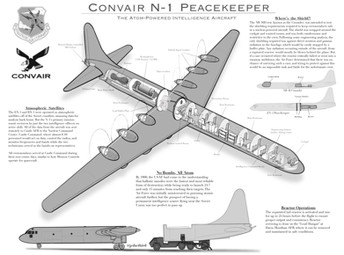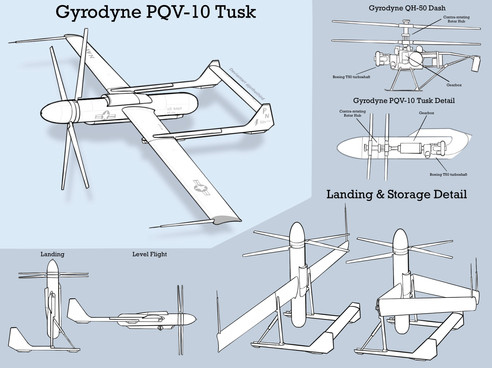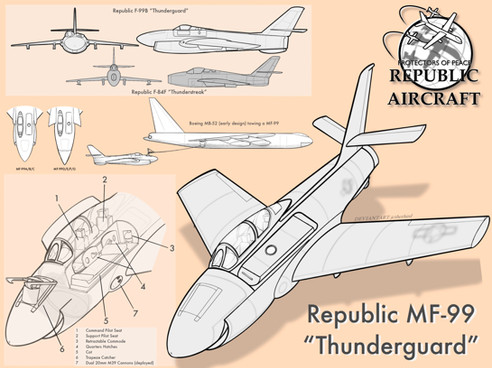HOME | DD
 jcthethird — Grumman-Interstate Q-3 Dronecat
jcthethird — Grumman-Interstate Q-3 Dronecat

#uav #aircraft #aircraftcarrier #alternateuniverse #drone #whatif #what_if #aircraftconcept
Published: 2021-11-24 05:33:43 +0000 UTC; Views: 19975; Favourites: 174; Downloads: 51
Redirect to original
Description
Note: all stories, drawings, and designs, while based on reality, are fictitious and “what-if”==Grumman-Interstate AQ-3 Drone==
The '''Grumman-Interstate Q-3 Dronecat''' is a twin-engine, unmanned aerial vehicle designed for carrierborne operations for the US Navy. The aircraft gained a lot of noteriety for being the first combat-capable unmanned aircraft to replace dangerous manned tasks, such as bombing missions and reconnaissance.
=






 esign and Development==
esign and Development==Following the first true [[Dogwalking (Tactic)|Dogwalking]] tests using the [[Grumman-Interstate ADR/ADF/Q-2 Buzzard|Interstate ADR Buzzard]], the US began looking ahead at the possibility of rapidly incorporating drones into everyday combat operations. Interstate Aircraft, which had been struggling since the release of the ADR, decided to look a step ahead for the next possible role the aircraft could take, and decided that thanks to advancements in the mechanical computers these aircraft could now carry they could perform more daring and dangerous missions than the ADR ever could.
To accomplish this, the US Navy would fund a research project to develop a next generation drone, and would end up creating the most articulated drone program in the world. While testing was performed using the TDR-2 aircraft, Interstate was thinking three steps ahead. Designs had begun on the XAD2R, a twin-engine build intended to launch off of the carrier deck and fly in similar manners to its F9F dogwalker aircraft. The design significantly resembled the US Air Force's Northrop F-89 Scorpion with a modified tail section and slightly-swept wings.
Despite the introduction of the research program, the financially struggling Interstate Aircraft would find itself in trouble, heavily relying on Grumman aircraft, their integrator, to manufacture large amounts of the equipment required for the project on a loan basis. To further cause issues, the US Navy would find Interstate liable for the deaths of two sailors aboard the USS Randolf when an ADR crashed on the deck following a textbook approach in 1955. After months of setbacks in the XAD2R program and reduced support for the ADR itself, Interstate approached Grumman with a deal. In early 1957, Grumman would acquire Interstate Aircraft, setting the company up as a separate drone research conglomerate within the Grumman ranks. The newly formed drone division became known as Grumman-Interstate and all subsequent aircraft were modified to the new name (ADR became the ADF and the XAD2R became the XAD2F).
Grumman-Interstate would propose 3 designs to fill the required roles presented by the US Navy. G-124A was a single-engine design that was intended for lighter loads, but longer endurance from full-sized carriers. The G-124B was the significantly modified Interstate twin-engine design, with the engines moved out to the middle of the wings to allow for a bomb bay and extra fuel. The G-124C was a modified version of the G-124B where the majority of the fuselage and the body was a flying bomb, and once dropped, the G-124C was considerably lighter. Ultimately, the US Navy would select the G-124B as the end design.
In the end, the XAF2F proposal greatly surpassed the Navy's requirements, with the aircraft being capable of carrying up to 12,000 lbs of munitions compared to the meager 5,000 the Navy asked for, as well as the added benefit of a combat range of 800 miles compared to the required 500.
===XAD2F===
While the ADF was relatively normal-sized compared to other attack aircraft, the XAD2F was intended to be bigger than the dogwalkers escorting it. It greatly surpassed the Navy's 5,000 lb payload requirement by carrying up to 12,000 lbs and a combat radius of over 800 miles, drawing further investments from the Navy to complete the program. The aircraft would test for the first time in 1959 out of NAS Miramar, powered by two "dry" J57 turbojets. By 1960, the afterburning J52 was installed, providing the XAD2F with enough force to successfully takeoff and land aboard an aircraft carrier. The aircraft would complete this task later that year when it landed aboard the USS Midway (CV-41), demonstrating that it was far easier to land than the ADF predecessor.
The test aircraft were heavily flown, with routine landings aboard specially modified carriers to test the approach and walking abilities of the aircraft.
===YAD2F===
Grumman-Interstate would roll out the first 10 YAD2Fs in 1960, with the aircraft modified for training Navy crews on operations and maintenance. The aircraft were significantly different than the XAD2F-2 in that they were now capable of landing semi-autonomously, they featured angled engines to improve single-engine flight, and improved antennas and comms systems.
On April 2, 1961, a dogwalker A4D-5D (later DA-4E) and two YAD2Fs were lost when the A4D-5D lost engine power and both crew were forced to eject. Because of no backup plan when there would be a loss of communication with the dogwalker, the YAD2F aircraft would follow the crippled leader into the Pacific Ocean. This would lead to Grumman-Interstate instituting a failsafe "return-to-ship" program if the lead aircraft was lost.
Following the Tri-Force Designation Act of 1962, the XAD2F was renamed the YAQ-3.
==Operational History==
The AQ-3A was approved for service in 1963, with the first commissioned units entering service in 1964. It would take two years for the aircraft to appear over Vietnam, during which time the aircraft was significantly tested back home.
===Vietnam War===
The first AQ-3 units were deployed to the USS Ranger and the USS Randolph in April of 1966, with operations commencing almost immediately. Very quickly the AQ-3s made a name for themselves, with the Navy being impressed at risking 2 men for 5-7 attack aircraft's worth of munitions instead of the usual 5-7. The AQ-3 was a routine sight in the North Vietnamese skies, with the Soviet GRU wondering how the US was able to develop something so powerful.
North Vietnamese forces would call them "Bats" given that they were effectively blind, and PAVN commanders would order that only AA guns were allowed to engage them since it was wasteful to shoot them down with missiles given their ease of replacement. When later discussed with the Vietnamese following the war, Vietnamese forces often called them (and the AQ-4) as the most demoralizing aircraft in the skies, as they were essentially dangerous but ultimately worthless to shoot down, as the aircraft had no pilot to ransom, so the PAVN would have to watch helplessly as the empty aircraft flew overhead.
====The East China Sea "Shootdown"====
On August 19, 1967, an AQ-3A of VUA-82 (number 02) was shot down by heavy anti-aircraft fire and would gently flop into a river delta near Hoa Binh. The aircraft was immediately recovered by Soviet GRU forces, hoping intently on recovering the computer and control setups the Americans had used in their unit. Fearing a booby trap in the aircraft, the Soviets kept the aircraft on the ground for a day before loading it in the back of an An-22 bound for Vladivostok. Unbeknownst to them, the AQ-3 had a magnesium block that was indeed booby-trapped with a thermite flint, however, the feature had most likely been shorted when it landed in the water. But once loaded on the aircraft, a timed breaker that was intended to prevent damage from shorts would flip on and the flint would initiate the magnesium burn. At an altitude of 21,000 feet, the AQ-3 would combust into an uncontrollable flame, with the Soviet aircrew failing to put the fire out. Intent on reaching Vladivostok, the aircrew began preparing to potentially airdrop the drone into the East China Sea and quickly abort to North Japan. However, the AQ-3 would cook-off a fuel reserve, setting fire to the An-22 itself. Crew aboard the An-22 abandoned the aircraft, calling for rescue in the East China Sea. South Japanese rescue crews would collect the 8 Soviet crewmembers in a HU-16 Albatross and fly them to Sapporo.
The drone (nicknamed "82-02" for its squadron and number) was jokingly credited with the "kill" back home, with the replacement "82-02" bearing the Soviet Air Force roundel along with the "An-22" identifier. The wreckage of the original aircraft was recovered and put on display in Pensacola, Florida at the Naval Aviation Museum, next to its first replacement that bears the kill marking. A subsequent 3 aircraft bore the "82-02" kill and designations before VUA-82 (then VUR-82) retired in 1992.
==






 ost-Vietnam===
ost-Vietnam===The Q-3 platform would continue to see improvements over the next decade following the end and withdrawl of US forces from Vietnam. British Aerospace, as part of an international deal with the United Kingdom, would assume control of the production of the aerial-refueling and attack variants for the Royal Air Force.
===Oceanic War===
''See also '''[[Wars#Oceanic War (1982)|Oceanic War]]'''''
The Royal Australian Navy would introduce the AQ-3 Dronecats in 1974 and began implementing them aboard their aircraft carriers for the later portion of the Vietnam War, but ultimately they would see little combat then. However, during the Oceanic War of 1982, the AQ-3K variant saw enormous amounts of usage against IPLN and IPLA forces on the various Indonesian islands. Towards the end of the war, the AQ-3K aircraft was a routine sight over the skies of Java and Sumatra, merriting little-to-no response from the Indonesian Air Force or its Defense Force.
====Battle of Surabaya====
Following the infamous RANS airstrikes on the Surabaya Bridge (precursor to the Suramadu Bridge), the Royal Australian Navy would continuously dispatch AQ-4Ks to strike the military installations on Madura and Gajam Islands, causing massive dissruptions to Indonesian defenses and the naval forces. Many Indonesian commanders regarded the AQ-4Ks as mosquitoes given their continuous presence over the islands, and many indicate that they helped lead to Suharta's overthrowing that year, as many citizens protested fighting an enemy that was as present and domineering as the Royal Australian Navy.
==






 ersian Gulf War===
ersian Gulf War===During Operation Desert Storm, the US Navy, Australian Navy, Royal Air Force, and French Navy heavily employed the Q-3 platform for engaging, attacking, and supporting against the Iraqi forces in the early stages of the conflict. As the fighting waned, the US and French Navies would use their AQ-3s to strike Iraqi targets near Kurdistan.
===Afghan and Iraq Wars===
US Navy and Marine forces heavily employed the AQ-4 for strikes in regions with a heavy A-A presence. The KQ-3 and the RQ-3 were also employed consistently throughout the war and surrounding threats.
==Operators==
*United States
**US Navy
**US Marines Corps
**NASA
*Confederated States
**CS Navy
*United Kingdom
**Royal Air Force
*Canada
**Royal Canadian Air Force
**Royal Canadian Air Force
*Australia
**Royal Australian Navy
**Royal Australian Air Force
*Taiwan
**Republic of China (Taiwan) Air Force
**Republic of China (Taiwan) Navy
*Hainan
**Republic of China (Hainan) Air Force
**Republic of China (Hainan) Navy
==Variants==
;XAD2F-1: Prototype aircraft powered by two Pratt & Whitney "dry" J57 turbojets, one built
;XAD2F-2: Prototype aircraft powered by two Pratt & Whitney afterburning J52 turbojets, one built and one converted
;YAD2F (YAQ-3A): Pre-production aircraft, 10 made
;AQ-3A: Production model of the YAQ-3A
;RQ-3A: Reconnaissance variant of the AQ-3A
;AQ-3B: Upgraded computer system and control interface, first exported variant
;KQ-3B: Aerial refueling variant of the Q-3B platform
;RQ-3B: Reconnaissance variant of the Q-3B platform
;AQ-3C: Upgraded variant of the AQ-3B with updated computers, air-to-air functionality with additional two hardpoints under folding wings for IR-guided missiles, and a pair of "dry" Allison TF41 (Spey) turbofans
;KQ-3C: Refueling variant of the Q-3C platform
;EQ-3C: Electronic Warfare variant of the Q-3C, featuring an extended nose and jamming pod on the dorsal of the frame.
;AQ-3K: Australian export variant for the Royal Australian Navy
;KQ-3K: Royal Air Force modified variant of the AQ-3C
;KQ-3KN: Australian Navy carrierborne aerial-refueler
;AQ-3D: Significantly updated AQ-3C, featuring new camera systems, satellite relays, and countermeasure systems for improved endurance
;KQ-3D: Aerial-refueling variant
;RQ-3D: Reconnaissance variant
;EQ-3D: Electronic warfare variant
;SQ-3D: Anti-submarine variant
==See Also==
*[[Dogwalking (Tactic)]]
*[[Grumman-Interstate ADR/ADF/Q-2 Buzzard]]
Related content
Comments: 15

👍: 1 ⏩: 1

👍: 2 ⏩: 0

👍: 2 ⏩: 1

👍: 1 ⏩: 0

👍: 1 ⏩: 1

👍: 1 ⏩: 1

👍: 0 ⏩: 0

👍: 1 ⏩: 1

👍: 1 ⏩: 0

👍: 1 ⏩: 1

👍: 0 ⏩: 0

👍: 1 ⏩: 1

👍: 0 ⏩: 0

👍: 1 ⏩: 1

👍: 0 ⏩: 0

























